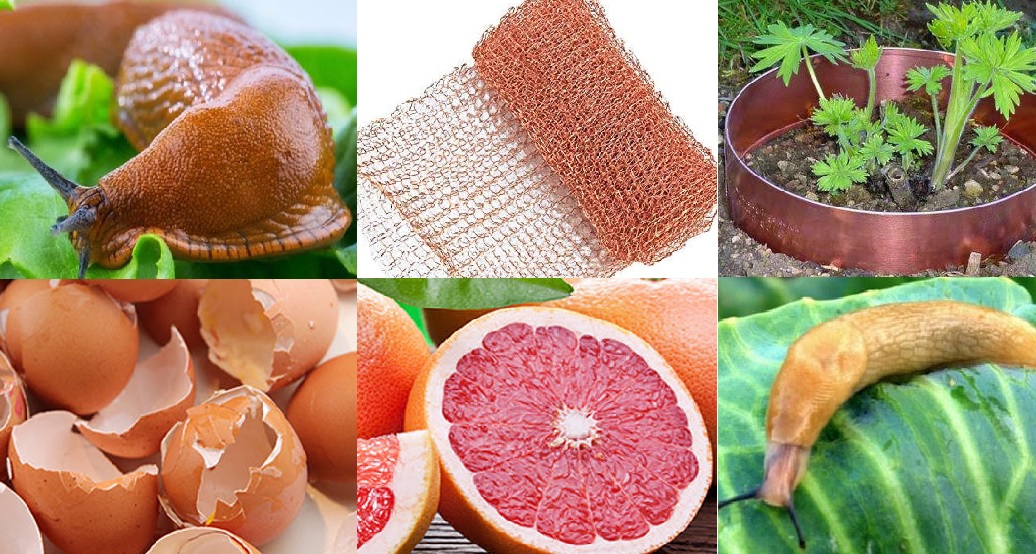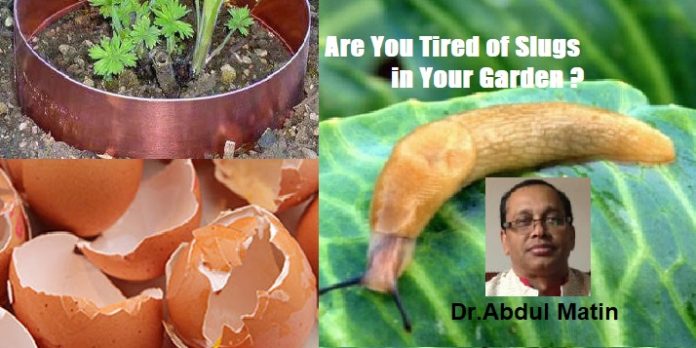Where do slugs come from at night?
Slugs are common and frustrating garden pest. They are prevalent in climates with ample moisture or humidity, and highly active during the wet seasons of the year. Yet even in the driest months, a well-irrigated garden provides snails and slugs good habitat! During the daytime slugs take cover in dense shrubs, leaf piles, under logs, stones or other damp and dark locations. They also hide under planters and low decks. They can also survive freezing conditions if they hide well enough. At night, they emerge and feed!
Ways of Controlling Slugs:
1. Cultural Control:
There are certain plants that slugs hate like the strong smell of mint, chives, garlic, geraniums, foxgloves and fennel. Plant them around the edge of your garden to keep them away.
2. Egg shells:
The sharp edges of eggshells help as a deterrent, but only when they are clean and dry. When peeling an egg, try to remove the inner membrane and rinse if needed. Be aware that rain quickly makes the eggshells lose their effectiveness.
3.Controlling Slugs Using Beer:
Some gardeners also use a bottle (or more) of beer to attract slugs. This functions as a homemade trap and takes a few days to work.
Open Beer-
Open the beer, and drink or pour out most of the contents. Leave just enough, so you can lay the bottles on their side and beer won’t spill out.
Place Bottles Around the Garden-
Place the bottles in various locations around your garden during the day. Lay each bottle on its side, and press it into the ground so the opening lies flush with ground level.
At nightfall, slugs should start entering the bottles because they’re attracted to the beer. Once inside, they will drown.
Leave the Bottles-
Leave the bottles in place for several nights. When they are full of slugs, remove them from the garden, empty them, and discard them in the recycling. Replace with new bottles if further treatment is necessary.
4. Coffee Grounds:
Sprinkle coffee ground around the bed. Coffee grounds strongly repels slugs. Slugs turn back immediately after contacting the caffeinated soil.
5. Controlling Slugs Using Organic Slug Bait:
Commercial slug control products should be used only for major infestations. Some traditional formulas can be extremely toxic to pets (and humans). Organic products are typically safer to use.
Purchase Slug Bait-
Purchase organic slug bait at your local garden center. Many products are made of iron phosphate, which is toxic to slugs but much less dangerous for humans and pets.
Check the weather. Make sure to treat on a dry day for best results.
Fill Garden Spreader With Granules and Start
Treating-
Around dusk, put on your gardening gloves, and fill your garden spreader with the granules. Follow the product’s instructions to determine the right amount for the area you’re treating.
Wait-
Wait for the slugs to feed on the product at night when they go underground. They will die upon consumption.
6. Vinegar kill slugs:
A spray bottle filled with plain white vinegar is a great cure for slugs that aren’t on plants. It should kill lots of slugs, and keep skeeters away for a good two weeks. It might even repel larger pests, like rabbits and deer!
7. Salt:
Sprinkle a pinch of salt on the slug and it kills it quickly. Not particularly pleasant but use as a last resort. Large quantities of salt will harm soil. Do not apply salt on your vegetable plants.
8. Garden Safe Slug & Snail Bait:
Buy them from any nursery (Hope depot, Rona, 99 Nursery, Walmart etc) and apply as per instructions.
9. Hot Chili powder:
Spray hot chilly powder in dry days around the plant to keep slugs away. Rains wash away chilly action.
10. Metaldehyde:
A pelleted pesticide used to attract and kill slugs by destroying their mucus production thus reducing their mobility and digestion. This is the most toxic choice for slug control and should be used only as a last resort.
11. Grape fruit traps:
Slugs are lovers of citrus. This means that fruits such as grapefruit can be used to make your own slug traps. Empty grape fruit rinds (peel) and place a couple of empty grapefruit rinds upside down on the ground, making sure there is enough clearance for a slug to enter. The grapefruit rind provides slugs with food, and a damp environment to hide. Leave overnight and dispose of any slugs caught in the morning.
12. Copper mesh, wire, tape or band:
Slugs and snails do not like to touch copper.
A chemical reaction happens when they crawl over the metal, which causes unpleasant feelings on their skin. Therefore, they avoid moving over copper. A good rule of thumb is broader the copper obstacle, the greater its effectiveness. The method may not be 100% effective because slugs mucus sometimes enables them to glide over these copper barriers. Copper barriers are more effective in pot and raised beds than grounds.
13. Natural Predators:
Animals such as hedgehogs, birds, beetles, frogs, and toads are all natural predators of slugs and love to tuck into these pests as a tasty snack. You just need skills, creativity, and a little patience Keep your backyard more appealing to these animals by building a hedgehog shelter, installing a pond and/ or setting up bird feeders. Introducing these animals into your garden will naturally control any slug infestation that might occur.
Conclusion:
Keep your garden cleans and visit garden every day specially in mid night with flash light and or early morning to check if you have slugs in your garden starts eating your lovely vegetable seedlings. Get ready to prevent or control them by any or combination of effective control measures. Do not make your garden a good habitat for slugs.
Gardening needs lot of hard work, dedication and skills. Happy gardening.








